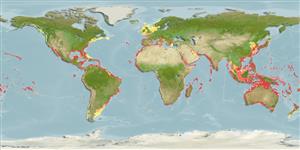Florideophyceae |
Gigartinales |
Hypneaceae
Environment: milieu / climate zone / depth range / distribution range
Ecology
Epiphytic; depth range 0 - 82 m (Ref. 102647). Tropical
Indo-West Pacific, Atlantic Ocean and the Mediterranean.
Length at first maturity / Size / Weight / Age
Maturity: Lm ? range ? - ? cm
Also reported to have medical and pharmaceutical uses such as muscle relaxants and blood agglutinins (Ref. 82232). Schenkman (1989) reported biomass of H. musciformis in Brazil to be most affected by high temperatures (such as during low spring tides on sunny days) followed by rough seas, and grazing by amphipods and seahares (Ref. 82232).
Life cycle and mating behavior
Maturity | Reproduction | Spawning | Eggs | Fecundity | Larvae
Seasonal reproductive cycle of H. musciformis tetrasporophytes and sterile plants predominated throughout the year in India. Plants reproduce vegetatively from regrowth of fragments (Ref. 82232).
Guiry, M.D. and G.M. Guiry. 2009. (Ref. 80701)
IUCN Red List Status (Ref. 130435)
CITES status (Ref. 108899)
Not Evaluated
Not Evaluated
Threat to humans
Human uses
Fisheries: commercial
| FishSource |
Tools
More information
Age/SizeGrowthLength-weightLength-lengthMorphologyLarvaeAbundance
Internet sources
Estimates based on models
Preferred temperature
(Ref.
115969): 17 - 28.8, mean 26.5 (based on 2446 cells).
